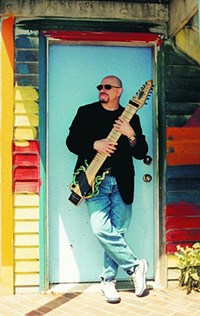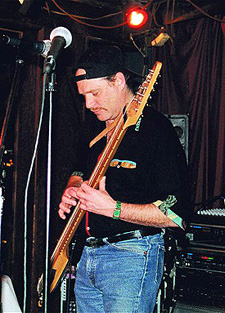
The Answer's Inside
‘I was very fortunate to land a guitar duo gig, once a week for two years. I was the house guitarist and every week I performed with different players. On a rotating basis, I performed with Jimmy Ponder, Jack Wilkens, Attilla Zoller, and even John Scofield before he had a recording out. There were others and the audience was always packed with guitarists. We had to be on top of our game and believe me, I learned a lot from the situation. Also at that time, I was involved with a cable TV show and I got to play some duets with Joe Pass and Tal Farlow. I also met Larry Coryell who, as you kn ow, recorded with me on my new CD. I played with some great instrumentalists. I had different groups that briefly included baritone sax legend Cecil Payne, Clifford Jordan on tenor sax, Sal Nistico on tenor, Tommy Turrentine on trumpet, Kenny Barron, Harold Mabern, both pianists, drummer Adam Nussbaum and many great local New York players. When I started playing Stick, I applied my jazz knowledge and played that repertoire b ut I also played jazz versions of the music I grew up with, Led Zeppelin, Pink Floyd and such. I prefer to play the music that is familiar to me, in the sense that it’s part of my being. When I perform, a set list could include Wes Montgomery, or Thelonious Monk, as well as Sting and the Grateful Dead.’
Alongside performing and recording, Steve has worked as a guitar, bass and Stick teacher for many years. He founded his own school, ‘The Guitar Workshop Inc.’ in 1977 after finding that teaching was taking more and more of his time.
‘I never stopped exploring t he guitar throughout my years. It was always inspiring to learn new styles and techniques. In the early 80’s, tapping seemed to be the new thing from Eddie Van Halen to Stanley Jordan. Of course, I attempted these stylings with different degrees of success. In 1984, I saw Emmett Chapman perform at a guitar convention in New York. That was it. I had to get a Stick. I had no idea what I was going do with it, but there were so many possibilities. After owning and playing my new Stick for a short time, it became evident that my guitar playing days were dwindling. A few years later I sold my Les Pauls and Gibson Super-400 and started buying more Chapman Sticks. I’ve probably owned about twenty Sticks over the years. I would continue to upgrade or MIDIify as my playing evolved. Right now I own four Sticks and only three inexpensive guitars that I use only for teaching.’
I wondered how the jazz community reacted to Steve when he first started to bring this radical new instrument to gigs and sessions.
‘Well at first, not well, partly because I wasn’t a very good player. How can a drummer like it if my timing wasn’t solid? As my music improved it became easier, but there were still some conservative horn players and drummers who would not accept what I was doing on this new instrument. Now that my playing is a lot more secure, it’s a different story. Larry Coryell’s a fan and other players are following. It’s very gratifying to hear positive feedback from peers that I respect.’

Taking into account the radically different tuning and playing position of the Chapman Stick I asked Steve how difficult he found it to adapt his technique from that of a guitarist.
‘Actually I found this part to be easy. The Stick i s so much more logically tuned than the guitar. There are less shapes to learn and the symmetry of the strings makes it easier to cover more advanced harmonic territory. I just applied basic music theory concerning chords and scales, found the shapes on the Stick fingerboard and looked for different musical combinations. The only difficult part was the two handed independence journey. I think I’ve finally arrived at a point where I can play with both hands, feel comfortable, be relaxed and actually explore the musical terrain with my ear as the guide.’
After three years of playing experience with the Stick Steve recorded his first cassette release, ‘Stickology’. The tape featured Alan Bates on vibes and Barry Brenner on drums and was reviewed very favourably in Guitar Player Magazine at the time. Steve followed that up with another cassette release, ‘Getting There’ and later his debut CD ‘Sailing Down The River, Sane’ which he describes as a mix of original and jazz instrumental covers arranged for Stick, vibraphone, percussion and drums.
As Steve said earlier he has owned around twenty Sticks over the years, he currently has four. One of them has an intricate snake carving as a feature and can be seen on the cover of ‘The Answer’s Inside’. I asked Steve to tell us about his current collection.
‘The Answer’s Inside’ features a whole host of guest musicians, under the banner ‘The New Sticktet’. Piano, guitar, vibes, steel pans and several drummers, grace individual tracks, perfectly complementing Steve’s inventive MIDI sounds. But how did he choose the individual musicians?
‘I’ve known most of the guys for a long time. I’ve worked with each at different times in my musical career. We had never played together as a unit though. We actually didn’t even get to rehearse. I met briefly with D ennis Moorman (piano) and Nydia Mata (percussion) before the session. Other than that, everything was done in the studio. I knew each player was creative but you never know how a session will end up. Well the chemistry was perfect from the start and it stayed that way through the two days in the studio. Everyone really listened musically and we achieved that full band feel. Also, everyone played through the entirety of each tune as opposed to solo and out. This gave us tons of orchestration capabilities and with everyone’s sensibilities, I was extremely pleased with the results. The session with Tony Levin and Jerry Marotta similarly was very smooth. I didn’t know how we were going to navigate two Sticks and not feel cluttered, but a simple regard for the music and ears did the trick. Sometimes improvisation can very tricky since you’re creating a musical conversation based on players input. For this CD, I couldn’t have asked for better results.’
Tony Levin is featured on the track ‘Woodstick Suite’. It’s also worth noting that the album’s opening track is called ‘Tone Eleven’ (say it aloud!). Legendary guitarist Larry Coryell features on ‘Nadda Chants. I asked Steve how he came to work with these two giants.
‘I’ve known Larry for quite a while and we’ve informally played together a few times over the years. I just asked him if he would contribute his talents to my new project. He agreed and we worked out the logistics. He was in town for a Blue Note gig, so I snuck him into the studio for a couple of hours in the afternoon. Likewise, I’ve known Tony for a few years. I had interviewed him for Twentieth Century Guitar magazine about six years ago, and again this month. We’ve been in touch, primarily at NAMM shows. I e-mailed him with the idea of doing a Stick duet and he graciously agreed and set it up at Jerry Marotta’s studio in Woodstock.’
Steve has been a regular contributor to Twentieth Century Guitar magazine for the last seven years, authoring a regular monthly column, which includes a guitar lesson.
‘The column is called “Voicings”. I also do a few interviews a year. I basically interview the people that I seek out, rather than doing assignments. My features have included Alan Holdsworth, Emmett Chapman, Steve Morse, Al DiMeola, Pat Martino, Tony Levin and Pat Metheny. I just met with Pat Metheny for our second time to be cover story in the April issue. A bonus was that I actually got a chance to jam with him. First he asked to try the Stick. He did great. Then we played together. I guess that’s really being accepted in the musical community. The magazine also produces an annual vintage guitar show that I demo the Stick at. That’s why the magazine is called Twentieth Century Guitar. They feature instruments throughout the twentieth Century. I’ve also written a little for DownBeat magazine.’
Steve is going to be teaching at the forthcoming World Stick Convention in Rome this year. I’ll be talking to it’s organiser, Virna Splendore elsew here in this issue, but here’s a little about it from Steve.
‘Virna decided to organise this convention. I believe it’s the second one she’s done. Anyway she put out an e-mail about the event and after correspondence we agreed I would be one of three teachers for the gathering. Greg Howard and Ron Baggerman are the other two. There will be three full days of Stick instruction and performance. I plan on teaching a wide range of things covering techniques, theory, Stick logic and just basic tools like chord chemistry and improv ideas. We’ll each bring our Stick experiences and share them with attendees. I’m very much looking forward to meeting the students and helping them further their musical explorations. I urge anyone who wants to learn more about the Stick to try and attend. It’s going to be a blast.’
Besides the Convention, the immediate future for Steve involves promoting ‘The Answer’s Inside’ in a variety of ways.
‘I’ve been shopping my new CD to same labels a nd although there’s been some interest, the industry climate is very depressed. I’m negotiating some higher profile gigs like regional jazz festivals. I’ve been playing a lot and feel that the next step is right around the corner. I hope to do more recording with a variety of projects. This last CD was very inspiring and I can’t wait till the next opportunity to create with these fine musicians. It’s hard to know where things will go, but I do know that I will be playing more than ever. The inspiration that I derive from the Stick is self motivating.’
